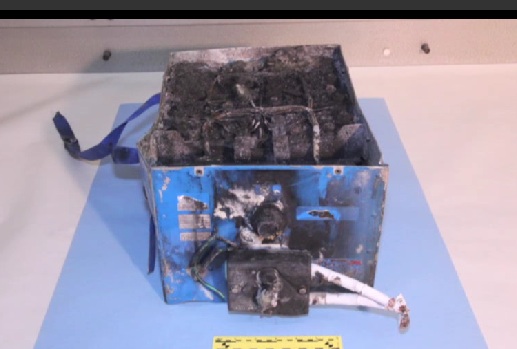

The burned auxiliary power unit battery from a JAL Boeing 787 that caught fire on Jan. 7 at Boston’s Logan International Airport. The dimensions of the battery are 19×13.2×10.2 inches, and it weighs approximately 63 pounds (new). Credit: NTSB.
A new press release from Lux Research criticizes Boeing for not spec’ing a safer lithium-ion battery chemistry for its fleet of 787s, which have been in the news because of aircraft fires (Jan. 7 and Jan. 16) that press reports link to onboard batteries. The FAA also has grounded all 787s of US air carriers until safety concerns can be reviewed.
Lux says that Boeing selected a high-energy battery type—lithium cobalt oxide (LCO)—that has an inherently high risk of thermal runaway. While the exact cause and sequence of events that led to the fires are still being investigated, Cosmin Laslau, Lux Research Analyst, says, “Boeing made a design decision favoring higher energy over safer options, and is now paying the price.”
The research group also notes that another company paying a price is GS Yuasa, the Japanese company that makes the batteries in question. Lux says the company’s stock value dropped 5 percent in one day.
Lux is puzzled by Boeing’s decision to opt for LCO batteries. In its release, Lux says
In choosing LCO, Boeing eschewed safer alternatives such as lithium iron phosphate (LFP). Even when overcharged, LFP changes only slightly in structure, preventing oxygen release and resisting thermal runaway. This decision is all the more shocking considering major automakers early on refused to entertain the possibility of using LCO in passenger vehicles due to safety concerns.
The New York Times reports that not everyone is criticizing Boeing. A story today quotes Hans Weber, president of aviation consulting firm Tecop as saying, “you cannot do pioneering work without assuming some risk… In today’s world, we don’t have to pay the price of pioneering with death anymore, but we have to accept the fact we will have some incidents.”
NYT also interviewed Northeastern University chemistry professor Sanjeev Mukerjee, who suggests that there may be multiple problems in the 787s battery systems. He bluntly told the newspaper, “If a battery of that size catches fire, then a whole bunch of mechanisms didn’t work. Whoever is making that battery is doing a really bad job.”
The National Transportation Safety Board removed the Li-ion battery that powered the auxiliary power unit on the airplane involved in the Jan. 7 incident and sent it to the NTSB Materials Laboratory in Washington. NTSB investigators plan to disassemble it this week. The agency also says that in advance of that work, an independent test facility conducted radiographic examination of the incident battery and a pristine battery. These radiographs and CT scans will be used to document the internal condition of the battery prior to disassembling it. The NTSB also notes that its investigators took possession of burned wire bundles, the APU battery charger, and several memory modules.
It important to note that despite some reports, the Boeing/Yuasa batteries are not the same as those used in automobiles.
The AP has also posted the following video about the battery problems of the 787:
